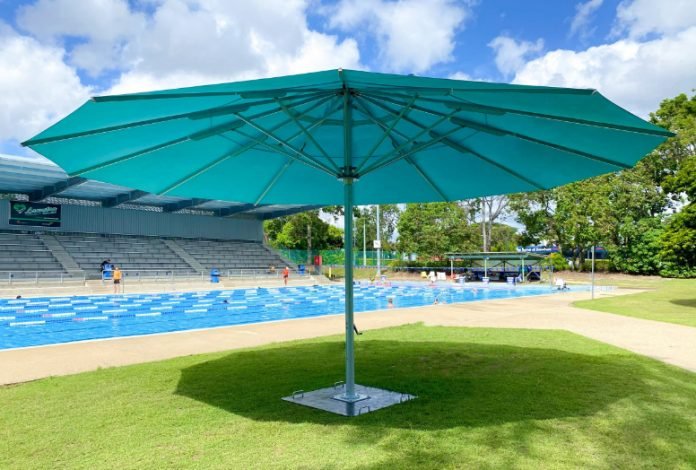Last Updated on February 7, 2025 by Bisma Sehar
Do you feel frustrated when you hear the rattling sound of your large outdoor umbrella in strong winds or when you see high winds toppling over your heavy duty umbrella? Well, it must be really annoying because you would have bought the café umbrellas thinking that they can withstand strong winds.
But let us tell you that it is a misconception that outdoor umbrellas can withstand strong winds. In simple words, you should never underestimate the force of the wind because it has enough strength to overturn an umbrella inside out and send the metal ribs flying everywhere. A few quality umbrellas can resist a strong gust of wind, but even then, one must exercise caution. A heavy duty umbrella is no match for sustained wind speeds and can damage your product.
The bottom line then is neither restaurant umbrellas, patio umbrellas nor cantilever umbrellas are built to face strong winds. In fact, they can just collapse in a storm. A strong gust of wind might simply drag both the support pole and the canopy fabric away from their stable places if the café umbrella is made of lightweight fabric. That is also not to say that an umbrella made of heavier fabric is not vulnerable to the wind. This is because the support beams beneath the canopy can snap easily under strong pressure from the wind.
But then, you cannot make do without an umbrella in Australian summers. Be it for residential or commercial purposes, large outdoor umbrella can shield you from the sun’s harmful rays.
So, we have devised a few ways through which you can secure your umbrella and make it more resistant to winds. To learn about them, read on…
Table of Contents
Material
If you want your umbrella to resist wind gusts, you have to choose the right fabric and frame for your product. A good quality product will ensure that the cloth of your umbrella doesn’t wear and tear easily while the pole remains stable. Both these factors will, in turn, increase the durability of the umbrella.
Some of the choicest fabrics are:
Acrylic:
This fabric is resistant to weather elements. It is not only weather resistant but also provides more than 95% protection from UV rays. It is waterproof and will last long.
Polyester:
Similar to acrylic, polyester is lightweight and adaptable fabric which is tough enough to resist tearing and shredding when exposed to moderate wind.
Olefin:
Olefin is a heavy-duty, resilient and eco-friendly outdoor fabric. It is long-lasting wind-resistant.
PVC vinyl:
One of the best materials that can resist winds. It is strong and resilient that is suitable to handle extreme Australian weather conditions.
For frames, some of the popular choices are:
Aluminium:
Aluminium offers you the best support when it comes to resisting strong winds. It is a lightweight, durable and versatile material that is corrosion-resistant. Large outdoor umbrella frames made of aluminium are extremely effective if you are living in windy areas.
Fiberglass:
Large outdoor umbrellas with fiberglass frames are flexible and therefore wind-resistant. One of the most durable products, fiberglass is lightweight and strong.
Steel:
Stainless steel doesn’t snap easily in high winds, making the umbrellas durable. It is a strong material that is also resilient to corrosion and rust.
Although you are now aware of the kind of materials that would stabilise your restaurant umbrellas or café umbrellas, it is crucial to remember that these models might not operate well in high winds or heavy wind gusts. We would also suggest you not to buy wooden-framed umbrellas. Wood might look aesthetic on your patio or backyard or restaurant’s outdoor area, but it can break easily and is not ideal in strong winds.
Heavy and broad base:
A large and heavy base will secure and stabilise your umbrella. The larger the diameter, the more resistant a heavy duty umbrella will be to strong winds. However, you must keep in mind to select an umbrella that will fit your patio table. You obviously don’t want to buy an umbrella with too big a base that can cause stability issues.
Additional weights:
Despite purchasing an umbrella with a large and heavy base, your device can be blown away by gusts of wind. So you place additional weights to stabilise your umbrella. There are various types of weights like sandbags, metal plates, or water weights that you can use.
Tilt and rotate mechanism:
Choose umbrellas that can be tilted, rotated, lifted, or lowered to allow movement from left to right, forward and backward without altering the umbrella base. With the wind changing direction throughout the day, the tilt function can be adjusted to offer a full 360-degree rotation.
Air vents:
A vented canopy is better suited to handle winds. This is because they allow air to pass through them and reduce the pressure on the canopy fabric. The umbrella becomes more stable as the vents ease the strain on its support system.
Conclusion
It’s crucial to remember that no umbrella is windproof. When the wind speed increases, we advise you against opening umbrellas. Large outdoor umbrellas that can open and close quickly are essential in strong winds. Also, it is important that you close your umbrella when you’re not using them. We now sincerely hope that you will be able to secure your umbrella in a better way after reading this blog.
Apart from this, if you are interested to know about Travel Without Insurance then visit our Travel category.
















